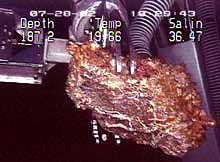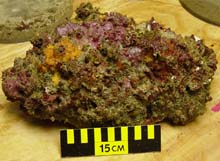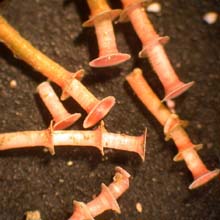 |
|
|
A large “live
rock” specimen is collected by the Johnson-Sea-Link
II at St. Augustine Reef. Click image for
larger view. |
| | Life on a Rock
July 29,
2002
Dr. Leslie Sautter
Geology Department,
College of Charleston
Project Oceanica
 Watch
a video of a "live rock specimen". (QuickTime, 1
Mb) Watch
a video of a "live rock specimen". (QuickTime, 1
Mb)
One of our mission
objectives is to investigate the rock that makes up the foundation
of the underwater oases. On each dive we are reassured that where
there is rock, there is life! Where no rocks occur on the seafloor
(except buried beneath the surface), the seascape consists of a
blanket of sand that has few visible forms of biota. The rocks that
outcrop, however, are completely enveloped in invertebrate
organisms, to the point that not a square centimeter of the actual
rock surface is exposed.
 |
|
|
Each rock is
photographed with a scale before we begin to pluck the
invertebrates from it. Many specimens were kept alive in
our shipboard aquarium. Click image for
larger view. |
| | To collect rock samples, we use the sub’s
powerful manipulator arm. Often the rock is too heavy to lift, or it
is firmly attached to the underlying rock pavement. Sometimes we are
able to recover a great specimen, which is then placed in the sub’s
collection basket. Once we are back on deck, the rock is hauled to
the wet lab for examination. I call this the “ooh-ahh phase” of the
research, when we examine and photograph the incredible biotic cover
of the live rock and begin documenting the specimen. It is at this
point that everyone—biologists, geologists, ship’s crew, and
others—all share in the excitement of the exploration. Watch the
video to see the initial on-deck processing of rock
samples.
Today we’ve had plenty of extra time to examine the
three rocks we recovered yesterday at the St. Augustine Scarp. On
each of these specimens, thick mats of brightly colored algae and
encrusting forms of both bryozoa and sponge wrap the rock surface in
a living cloak of vibrant color.
 |
|
|
A turkey wing
mussel (Genus Arca) is found living within a bored hole,
firmly attached to the rocky substrate. Click image for
larger view. |
| | Soft coral, bivalves (e.g., clams and mussels),
barnacles, and polycheate tube worms all claim their own territory,
affixed to either the rock surface or in self-made, rock-lined bored
holes. A variety of small
crustaceans (e.g., crabs and amphipods), echinoderms (e.g., sea
urchins and brittle stars) make their homes among the pits and
holes, foraging through the dense overgrowth of their surrounding
environment. Worms that make specialized tubes in which to live are
numerous and can be found in a variety of forms.
All these invertebrates make their home on the
available hard seafloor, or “rocky substrate,” as they require an
immobile surface on which to live. The nearby Gulf Stream supplies
the region with strong currents, making the shifting, sandy seafloor
difficult to inhabit. This diverse group of opportunistic
invertebrates takes great advantage of any exposure of such
“hardground.” The rock-bound communities differ slightly from rock
to rock, perhaps due to local currents or other environmental
conditions. Local predators may also influence the community
composition.
 |
|
|
Tiny tubes
built as housing by serpulid tube-worms were clustered
in a small forest-like grove on one of the rocks
collected. These tubes are approximately 0.5 cm in
length and were viewed through a dissecting microscope
on board the ship. Click image for
larger view. |
| | Once we return to shore, the rocks will be dried
until they no longer have an overpowering odor of decay (!). Then
they will be broken into smaller pieces and analyzed for their
mineralogical content (composition) and grain size. While on the
ship, however, we will continue to examine them as living rocks and
value them as the foundation of the deep underwater oases along the
edge of the southeast U.S. continental
shelf.
(top)
|
|
|

